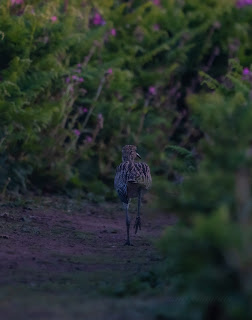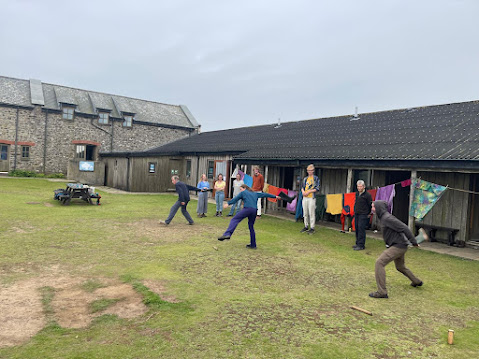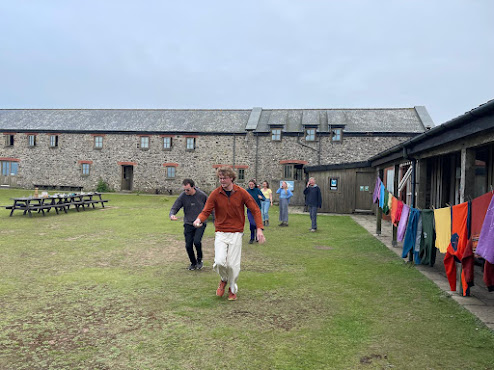Take a look at what our LTVs Molly and Amy have been up to during June and early July!
Seabird counting
We both feel extremely grateful
for the opportunity to help the island team with seabird counts this year as long-term
volunteers.
Counting guillemots, razorbills,
fulmar and kittiwake from both land and boat takes great practise, land counts
enabled us to get a good feel for counting, with the Mew Stone as our first
mission. Razorbills tucked away in crevices and guillemots huddled together
tight on the cliffs; it was fun to get our eye in and learn how technical, but
rewarding, counting can be. Boat counts were great too, with a little more
experience under my belt it allowed for the added element of sea swell! Seeing
Skomer Island from the sea is extraordinary, the volcanic geology and beautiful
lichen covered cliff faces really blew me away. Counts are done as
systematically as possible, with the island split into sections using boundaries
such as cliff cracks. Teams of two will take a species within that section and
using clickers the counting begins! Teammates will compare counts completed in
a section and must be within 10% of each other, an average is then taken. All
counts from each section are then combined to give a total island population
for each species.
Helping with manx shearwater
census involved playing calls into burrows, across many plots around the
island, and documenting call back response. This yearly census allows members
of staff to assess the current state of the manx shearwater population on Skomer
Island. Whole island counts are completed every 10 years. Helping out gave us an
opportunity to see some areas of the island usually left unvisited; all covered
in tall bracken and hidden burrows!
 |
| Amy counting the guillemots and razorbills at the Pigstone |
 |
| Molly counting the seabirds at The Wick |
Chough have been a joy to monitor on Skomer Island. Locating
nest sites tucked away in the cliffs, distinguishing each pairs breeding stage
throughout the season and differentiating adults with fledglings has allowed me
to learn so much about this member of the corvid family. Currently, 8 out of 10
pairs holding territories have fledged chicks. Completing my report will give
clear evidence of breeding behaviour, location of nest sites and foraging
areas. It will be interested to compare Skomer Islands 2025 productivity with
other chough populations around Pembrokeshire once reports have been released.
Razorbill and Curlew updates
The razorbill monitoring has been an absolute highlight from
my time here on Skomer. Getting to spend so much time at Bull Hole every day, sat on a cliff edge, scope at the ready and binoculars glued to my eyes! Looking at my 117 pairs to see what they were doing, waiting
for each one to move to see if they’d reveal an egg or a chick that was hiding
beneath them, an excitement like no other! Then watching the little grey fluff balls grow and then fifteen days after hatching watching them take the leap of faith as they begin to fledge. Day by day the cliffs would become quieter as more and more chicks took the plunge and now only a few remain.
.jpg) |
| A razorbill chick being closely guarded by its parents, photo by Amy Compton |
 |
| A curlew chick running down the path, photo by Amy Compton |
 |
| A curlew in a pretty pink sunset, photo by Amy Compton |
Grassholm Trip
To celebrate the completion of seabird season, staff, volunteers and researchers had the opportunity to take a boat trip around Grassholm Island. I had never been before and seeing this magnificent island up close was like nothing I had ever experienced before. Grassholm is visible from Skomer but distinguishing its size and the seabird colonies that call the island home were always difficult. I can now confirm, as I have included in many Skomer welcome talks, the island’s white appearance is for certain gannets and all their guano! The island was truly covered. The array of juvenile plumage, adults soaring above the boat, groups diving, it was a spectacle. The speckled white and black of juvenile wing pattern resembled the keys of a piano, with everyone looking slightly different. As of 2024, Grassholm Island is home to 19,199 AOS (Apparent Occupied Sites) of gannets. Due to a huge hit of Avian flu in 2022, Grassholm gannet numbers dropped from 34,491 AOS in 2022 to 16,000 AOS in 2023 (Morgan and Stephens 2024). Let’s hope 2025 numbers continue to show an increase in gannet numbers as seen between 2023 and 2024.
 |
| Everyone looking up at the gannets in amazement |
 |
| All smiles after a great boat trip to Grassholm |
 |
| A gannet gliding over the water at Grassholm, photo by Amy Compton |
Skomer Pride
As a team on Skomer and as part of the wider Wildlife Trust
community, representation is extremely important to us. It was great to
celebrate Pride and demonstrate to others that diversity is what makes this
world a wonderful place. Queerness can be seen across nature; humans are no
exception! Some bird species breeding on Skomer Island are also included in
Bagemihl’s (1999) list of birds displaying homosexual behaviour. Kittiwake, raven
and guillemot are all included, how amazing and beautiful are our ecosystems.
The evening involved a potluck and an array of party games, welly throwing, egg
and spoon race and even hide and seek. Once again, I am left unsurprised at the
level of competitiveness this island holds. We all got rather invested. I am
however, left surprised at how hard welly throwing is I must admit! The Trig
Point made for a lovely sunset watching spot, the sky was set on fire with
pinks and oranges. The celebration was bought to a close with a campfire, sing
song and vast quantity of Manx shearwaters darting above our heads in the night
sky.
 |
| Island staff and volunteers celebrating Skomer pride |
 |
| In action! Welly wanging fun! |
Jumpling watching
As dusk began to settle over the island, anticipation fell
over the small group of us gathered at the Amos. The air was filled with the
calls of the guillemot chicks as they prepared to take the plunge! Then it
began.
One by one tiny fluffballs no bigger than a fist, detached
themselves from the rock face. They took the leap of faith, tumbling, rolling
and bouncing off the cliffs and most of them hit the water with a surprising
gentle splash! Waiting patiently below, bobbing on the waves were the proud
fathers, ready to guide their courageous offspring out into the vast open sea.
Watching a jumpling take its leap is not just watching a
bird fledge, it’s a heart wrenching moment waiting for each one to make the
plunge, gasps and cheers could be heard as each one successfully made it, it’s
a privilege to be on Skomer at this time of year, to witness this extraordinary
natural phenomenon.
 |
| A guillemot with its cute fluffy chick |
Weighing chicks and gull ringing
Over the past few weeks, we have been lucky enough to get
involved in hands on experience helping out Freya and Duncan with the weighing
of the cutest little razorbill chicks and pufflings! Each chick had its tiny
wing length meticulously measured, they were carefully weighed and if they were
big enough, they would be ringed too, this is all done to measure their growth
rates.
Another recent island activity we got involved in was the lesser black backed gull catching, this is done to monitor their breeding success. This involved searching through dense tall bracken for the chicks some of which would hunker down and be easily caught while others would decide to run and put up a fight! So, you’d then have to quickly follow the rustling of the bracken and sometimes run after them if they came out into a clearing, and try to avoid being bitten, scratched, and thrown up on when you eventually caught them! They would then be ringed under licence before being released.
 |
| Amy holding a razorbill chick |
 |
| Molly holding a cute fluffy puffling |
 |
| Amy holding a gull chick after hunting through the dense vegetation |
Goodbyes
In mid July I said my goodbyes, or
rather a see you soon! Skomer Island has unsurprisingly left me feeling more
connected to wildlife than ever before. I will be eternally grateful for my
time on this magnificent island, and I can’t wait to return again. -Molly
Thanks for reading

No comments:
Post a Comment